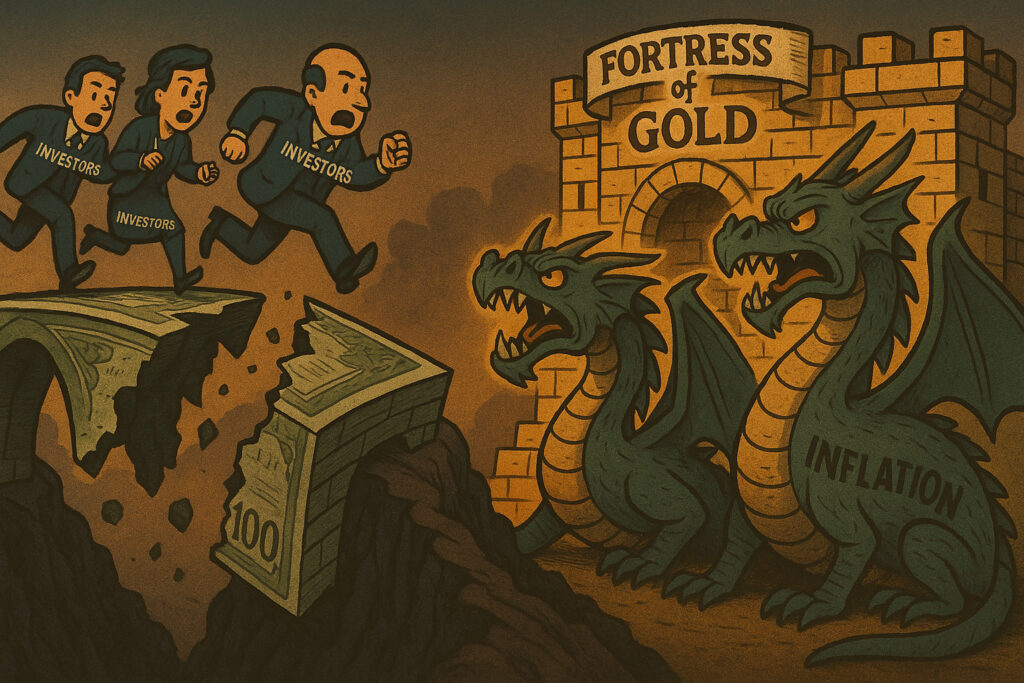Introduction
Gold prices surged on July 3, 2025, climbing above the critical $2,400-per-ounce level as investors flocked to safe-haven assets ahead of the highly anticipated U.S. Nonfarm Payrolls report due on July 5. The metal rose 1.2% to settle at $2,429 per ounce, its highest closing level since late May, as market participants hedged against potential surprises in labor market data and the evolving monetary policy landscape.
The rally in gold was driven by a combination of macro uncertainty, heightened geopolitical risk, and shifting expectations around the Federal Reserve’s next move. With U.S. economic data sending mixed signals and the Fed remaining cautious, gold has become an increasingly attractive asset for portfolio diversification and inflation protection.
This article explores the catalysts behind the latest move in gold, analyzes cross-asset market reactions, and discusses the broader implications for investors and policymakers.
Gold’s Breakout: Above $2,400 Once Again
Gold’s ascent past $2,400 reflects a confluence of supportive factors:
- Pre-Jobs Report Hedging
Investors have become increasingly wary of volatility surrounding the June jobs report. A significant downside surprise could prompt a sharp repricing of Fed policy expectations, while a stronger-than-expected reading may fuel concerns about sticky inflation. Gold offers a hedge against both scenarios. - Inflation Concerns Persist
Despite recent moderation in CPI and PCE readings, core inflation remains above target, especially in services. Gold’s appeal as an inflation hedge continues to attract institutional demand, particularly from central banks and sovereign wealth funds. - Geopolitical Risk
Rising tensions in the Middle East and renewed instability in parts of Eastern Europe have reignited geopolitical risk premiums. Demand for non-correlated, globally liquid assets like gold has surged as a result. - Technical Momentum
The break above $2,400 triggered momentum buying and short covering, reinforcing the upward move. Gold is now up nearly 14% year-to-date and 3.5% over the past week alone.
Market Reactions: Cross-Asset Trends
Equities: U.S. stock markets posted modest gains ahead of the July 4 holiday. The S&P 500 rose 0.3% to 5,239.01, the Nasdaq Composite edged up 0.4% to 16,513.32, and the Dow Jones added 0.2% to 39,112.45. Investors rotated slightly toward defensive sectors, with consumer staples and utilities outperforming.
Bonds: Treasury yields declined, reflecting safe-haven flows. The 10-year yield fell 5 basis points to 4.36%, while the 2-year yield dipped to 4.70%. The yield curve remained inverted, signaling continued concern over medium-term economic prospects.
U.S. Dollar: The greenback was little changed, with the Dollar Index (DXY) flat at 105.65. EUR/USD held at 1.0650, while USD/JPY hovered around 160.55. Markets appear to be awaiting Friday’s labor data for clearer direction.
Commodities:
- Silver followed gold higher, gaining 1.8% to $31.45 per ounce.
- Copper edged up 0.6% to $4.34 per pound amid improving sentiment around U.S. manufacturing.
- Oil prices were steady, with Brent at $70.58 per barrel and WTI at $66.76.
Cryptocurrencies: Bitcoin held near $73,600, while Ethereum gained 0.4% to $3,968. Digital assets remain range-bound, awaiting macro clarity and regulatory developments.
Central Bank and ETF Demand
Central banks have been major buyers of gold in 2025, continuing the accumulation trend from the previous two years. According to the World Gold Council, global central bank purchases totaled over 1,100 tonnes year-to-date, led by China, Turkey, and India. These flows have helped offset selling from Western ETFs.
Gold-backed ETFs saw net inflows of $550 million over the past week—the highest weekly intake since early April. SPDR Gold Shares (GLD) rose 1.4% on the day, while iShares Gold Trust (IAU) added 1.3%.
Technical Indicators: Bullish Signals
Technical analysis confirms the bullish momentum:
- Gold has broken above both its 50-day and 200-day moving averages.
- RSI remains elevated at 68, just below overbought territory.
- Key resistance is now seen at $2,450, with support at $2,385.
Traders note that sustained closes above $2,400 could trigger further upside, especially if Friday’s jobs data supports dovish policy repricing.
Fed Watch: All Eyes on Labor Data
The June FOMC minutes released July 2 reiterated the Fed’s data-dependent stance. Policymakers remain cautious, acknowledging disinflation progress but seeking confirmation before adjusting rates.
Friday’s jobs report could be pivotal:
- A soft report (e.g., <150k jobs, rising unemployment) could boost odds of a September rate cut.
- A strong report (>200k jobs, firm wage growth) may delay easing and pressure risk assets.
Fed futures currently imply a 58% probability of a 25-basis-point cut by September, down from over 70% two weeks ago. Chair Jerome Powell is scheduled to speak on July 10, and markets expect him to address the evolving outlook in light of incoming data.
Macro Context: Caution Prevails
The broader macro backdrop supports gold’s strength:
- Global PMI data remain mixed, with the U.S. showing modest recovery but China and Europe still soft.
- Fiscal policy in major economies remains constrained, limiting growth upside.
- The corporate earnings season kicks off next week, with guidance likely to be cautious amid margin pressures.
These dynamics suggest that risk appetite could remain constrained, especially if macro surprises lean negative.
Conclusion
Gold’s rally above $2,400 on July 3 reflects mounting investor caution ahead of critical macro events. With the June jobs report looming and central banks still data-dependent, gold has reasserted its role as a hedge against both economic and policy uncertainty.
The confluence of geopolitical risk, central bank buying, and volatile economic signals has created fertile ground for continued strength in precious metals. As U.S. and global markets brace for a potentially turbulent July, the momentum in gold could persist, particularly if labor and inflation data disappoint.
Investors will closely monitor:
- Friday’s Nonfarm Payrolls for confirmation of labor market trends
- Powell’s remarks on July 10 for clues on the Fed’s policy path
- Central bank activity and ETF flows for sustained demand signals
In the current environment, gold remains a key strategic asset—not just for traders chasing technical breakouts, but for portfolio managers seeking insulation from macro volatility.
